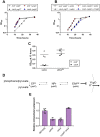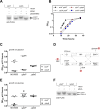The Phosphohistidine Phosphatase SixA Targets a Phosphotransferase System
- PMID: 30482831
- PMCID: PMC6282199
- DOI: 10.1128/mBio.01666-18
The Phosphohistidine Phosphatase SixA Targets a Phosphotransferase System
Abstract
SixA, a well-conserved protein found in proteobacteria, actinobacteria, and cyanobacteria, is the only reported example of a bacterial phosphohistidine phosphatase. A single protein target of SixA has been reported to date: the Escherichia coli histidine kinase ArcB. The present work analyzes an ArcB-independent growth defect of a sixA deletion in E. coli A screen for suppressors, analysis of various mutants, and phosphorylation assays indicate that SixA modulates phosphorylation of the nitrogen-related phosphotransferase system (PTSNtr). The PTSNtr is a widely conserved bacterial pathway that regulates diverse metabolic processes through the phosphorylation states of its protein components, EINtr, NPr, and EIIANtr, which receive phosphoryl groups on histidine residues. However, a mechanism for dephosphorylating this system has not been reported. The results presented here suggest a model in which SixA removes phosphoryl groups from the PTSNtr by acting on NPr. This work uncovers a new role for the phosphohistidine phosphatase SixA and, through factors that affect SixA expression or activity, may point to additional inputs that regulate the PTSNtrIMPORTANCE One common means to regulate protein activity is through phosphorylation. Protein phosphatases exist to reverse this process, returning the protein to the unphosphorylated form. The vast majority of protein phosphatases that have been identified target phosphoserine, phosphotheronine, and phosphotyrosine. A widely conserved phosphohistidine phosphatase was identified in Escherichia coli 20 years ago but remains relatively understudied. The present work shows that this phosphatase modulates the nitrogen-related phosphotransferase system, a pathway that is regulated by nitrogen and carbon metabolism and affects diverse aspects of bacterial physiology. Until now, there was no known mechanism for removing phosphoryl groups from this pathway.
Keywords: CvrA; PtsN; YcgO; histidine phosphatase; histidine phosphorylation.
Copyright © 2018 Schulte and Goulian.
Figures



Similar articles
-
The phosphohistidine phosphatase SixA dephosphorylates the phosphocarrier NPr.J Biol Chem. 2021 Jan-Jun;296:100090. doi: 10.1074/jbc.RA120.015121. Epub 2020 Nov 23. J Biol Chem. 2021. PMID: 33199374 Free PMC article.
-
The phosphotransferase protein EIIA(Ntr) modulates the phosphate starvation response through interaction with histidine kinase PhoR in Escherichia coli.Mol Microbiol. 2012 Oct;86(1):96-110. doi: 10.1111/j.1365-2958.2012.08176.x. Epub 2012 Aug 3. Mol Microbiol. 2012. PMID: 22812494
-
An Escherichia coli protein that exhibits phosphohistidine phosphatase activity towards the HPt domain of the ArcB sensor involved in the multistep His-Asp phosphorelay.Mol Microbiol. 1998 Feb;27(3):573-85. doi: 10.1046/j.1365-2958.1998.00703.x. Mol Microbiol. 1998. PMID: 9489669
-
Mechanism of regulation of the bifunctional histidine kinase NtrB in Escherichia coli.J Mol Microbiol Biotechnol. 2002 May;4(3):229-33. J Mol Microbiol Biotechnol. 2002. PMID: 11931552 Review.
-
Transcriptional regulation of the bgl operon of Escherichia coli involves phosphotransferase system-mediated phosphorylation of a transcriptional antiterminator.J Cell Biochem. 1993 Jan;51(1):83-90. doi: 10.1002/jcb.240510115. J Cell Biochem. 1993. PMID: 7679391 Review. No abstract available.
Cited by
-
The ArcAB Two-Component System: Function in Metabolism, Redox Control, and Infection.Microbiol Mol Biol Rev. 2022 Jun 15;86(2):e0011021. doi: 10.1128/mmbr.00110-21. Epub 2022 Apr 20. Microbiol Mol Biol Rev. 2022. PMID: 35442087 Free PMC article. Review.
-
Global control of bacterial nitrogen and carbon metabolism by a PTSNtr-regulated switch.Proc Natl Acad Sci U S A. 2020 May 12;117(19):10234-10245. doi: 10.1073/pnas.1917471117. Epub 2020 Apr 27. Proc Natl Acad Sci U S A. 2020. PMID: 32341157 Free PMC article.
-
The phosphohistidine phosphatase SixA dephosphorylates the phosphocarrier NPr.J Biol Chem. 2021 Jan-Jun;296:100090. doi: 10.1074/jbc.RA120.015121. Epub 2020 Nov 23. J Biol Chem. 2021. PMID: 33199374 Free PMC article.
-
Factors governing attachment of Rhizobium leguminosarum to legume roots at acid, neutral, and alkaline pHs.mSystems. 2024 Sep 17;9(9):e0042224. doi: 10.1128/msystems.00422-24. Epub 2024 Aug 21. mSystems. 2024. PMID: 39166858 Free PMC article.
-
Interaction of unphosphorylated PtsN with the K+/H+ antiporter YcgO inhibits its activity in Escherichia coli.J Biol Chem. 2025 Feb;301(2):108153. doi: 10.1016/j.jbc.2024.108153. Epub 2024 Dec 30. J Biol Chem. 2025. PMID: 39742999 Free PMC article.
References
Publication types
MeSH terms
Substances
Grants and funding
LinkOut - more resources
Full Text Sources
Molecular Biology Databases
Research Materials

